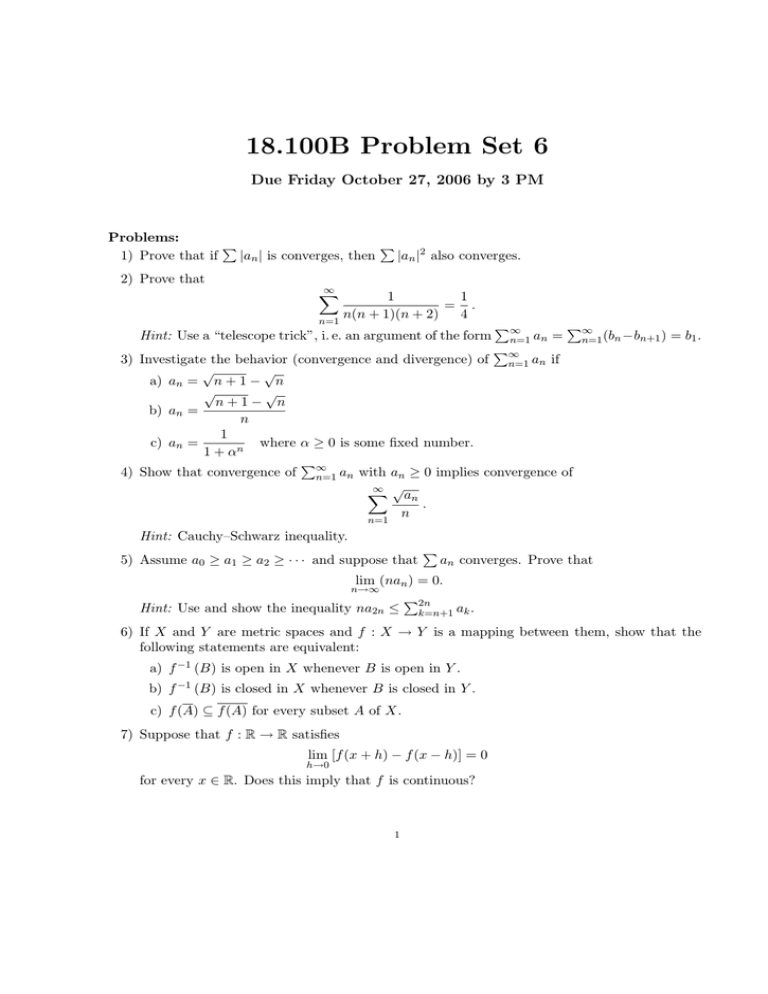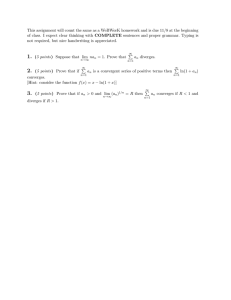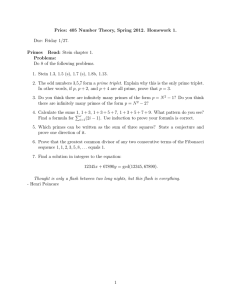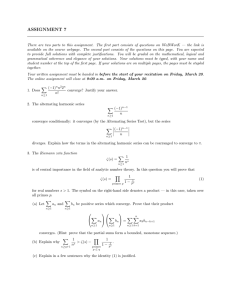Document 13438186
advertisement

18.100B Problem Set 6
Due Friday October 27, 2006 by 3 PM
Problems:
�
�
1) Prove that if
|an | is converges, then
|an |2 also converges.
2) Prove that
∞
�
n=1
1
1
= .
n(n + 1)(n + 2)
4
Hint: Use a “telescope trick”, i. e. an argument of the form
�∞
n=1 an
�∞
n=1 an
=
�∞
n=1 (bn −bn+1 )
= b1 .
3) Investigate the behavior (convergence and divergence) of
if
√
√
a) an = n + 1 − n
√
√
n + 1 − n
b) an =
n
1
c) an =
where α ≥ 0 is some fixed number.
1 + αn
�
4) Show that convergence of ∞
n=1 an with an ≥ 0 implies convergence of
∞ √
�
an
.
n
n=1
Hint: Cauchy–Schwarz inequality.
5) Assume a0 ≥ a1 ≥ a2 ≥ · · · and suppose that
�
an converges. Prove that
lim (nan ) = 0.
�
Hint: Use and show the inequality na2n ≤ 2n
k=n+1 ak .
n→∞
6) If X and Y are metric spaces and f : X →
Y is a mapping between them, show that the
following statements are equivalent:
a) f −1 (B) is open in X whenever B is open in Y .
b) f −1 (B) is closed in X whenever B is closed in Y .
c) f (A) ⊆ f (A) for every subset A of X.
7) Suppose that f : R → R satisfies
lim [f (x + h) − f (x − h)] = 0
h→0
for every x ∈ R. Does this imply that f is continuous?
1
Extra problems:
1) Consider the non-absolutetly convergent series
∞
�
1 1 1 1 1
ak = 1 − + − + − + · · ·
2 3 4 5 6
k=1
�
Find a rearrangement ∞
n=1 akn that diverges to +∞.
2) Let (pk ) = (2, 3, 5, 7, 11, . . .) be the sequence of prime numbers. Prove that the series
∞
�
1
k=1
pk
diverges, for�instance, by working out the details of the following argument.
1
Suppose
pk converges. Then, there is an integer � such that
∞
∞
�
�
1
1
1
=
< .
pk
pk+�
2
k=�+1
(∗)
k=1
Next, for any given x ≥ 0, we let N (x) be the number of positive integers n ≤ x that are
not divisible by any prime pk with k > �. By writing n = km2 with k square-free (which
can be done with any integer), prove that
√
√
x
< N (x) < 2� x.
N (x) ≤ 2� x and conclude that
2
2�+2
This is a contradiction whenever x ≥ 2
holds.
Trivia: As an amusing fact, we remark that the series
∞
�
�1
1 � �1 1� �1 1� � 1
1� �1
1� �1
1�
+
+
+
+
+ ···
+
=
+
+
+
+
+
pk
qk
3 5
5 7
11 13
17 19
29 31
k=1
is known to converge. Here (pk , qk ) runs over the pairs of twin primes; that is, pk and qk are
both prime and qk = pk + 2. This result was proved by V. Brun in 1919, and it is known
today (by numerics) that the value of the series is ≈ 1.902.
Had this series (∗) diverged, we would have a proof of the twin prime conjecture which
means that there are infinitely many twin primes (this is still not known!). Also, if we knew
that the value of (∗) were an irrational number, then the twin prime conjecture would follow
immediately.
3) Let (pk ) be the sequence of prime numbers, and let JN denote the set of natural numbers
whose factorization into primes only involves the primes {pk : 1 ≤ k ≤ N }. Prove the
following identity
N
� 1
�
1
=
s
n
1 − p−s
k
n∈J
k=1
N
for any N ∈ N and any s ∈ Q ∩ (1, ∞). From this deduce Euler’s formula
∞
N
∞
�
�
�
1
1 �
1 �
=
lim
=:
ns N →∞
1 − p−s
1 − p−s
k
k
n=1
k=1
k=1
MIT OpenCourseWare
http://ocw.mit.edu
18.100B Analysis I
Fall 2010
For information about citing these materials or our Terms of Use, visit: http://ocw.mit.edu/terms.









